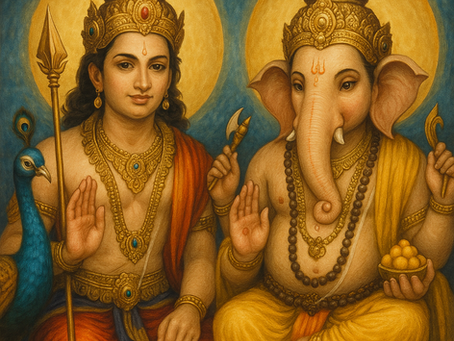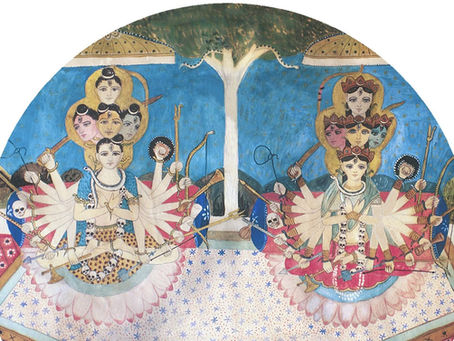top of page
Search


Significance of Pranayama in Narasiṁha upasana for attainment of siddhi:
वृहद नृसिंह उपासना कल्पस्य चतुर्थ पटले नारद प्रल्हाद संवादे नृसिंह बीजाक्षर मन्त्र प्राणायामनिरूपणे नारदस्य वचनांतर्गत: मासात्संल्लक्षणंप्राप्य षण्मासेपवनाभवः त्रिकालेसिद्धिमाप्नोति प्राणायामेन चतुर्विंशति सदाभ्यासीवशीभूत्वा पवनंजनयेत्पुमान् षण्मासाभ्यंतरेसिद्धि रितियोगार्थनिर्णयः प्राणायामात्परंनास्ति पापराशिक्षयायच सर्वपापक्षयेयाते किंनसिध्यतिभूतले॥ प्राणायामंविना तात कुत्रसिद्धोभवेन्नरः॥ सर्वसिद्धिक्रियासारं प्राणायामंपरंस्मृतम्॥ vṛhada nṛsiṃha upāsanā kalpasya caturtha p
Laxmi Narasimha Sadhana kendra
Nov 65 min read


Skanda and Ganesha:
In the Puranas, Ganesha has a brother who has several well known names such as Skanda, Kumāra (the child), Kumaraswamy, Subramanya, Shanmugha (the six-faced one) and others. Is there a Vedic counterpart to this deity? The answer is yes. This aspect is mentioned by Sri Aurobindo and is discussed in great detail by Sri Kapali Sastry (KS), (Collected Works, Vol. 1, pp. 84-88). The counterpart of Skanda in Veda is Agni. "But the Puranic story of Skanda, Kumāra, the Child, closely
Laxmi Narasimha Sadhana kendra
Nov 65 min read


Skanda yāgaḥ athavā dhūrta kalpaḥ of atharvaveda :
This description of the Skanda yaga from the dhūrta kalpa of atharva veda pariśiṣṭha is for educational purposes only. We have signalled towards the mantras and the kriyas to be used in the yaga procedure with: The mention of relevant truncated verses from the Vedas to be used for officiating purposes of the kriyas and brief direction towards the kriya itself One compulsorily needs to undergo atharvavediya upanayan to conduct this yaga. Or one must get dikshita from a atharv
Laxmi Narasimha Sadhana kendra
Nov 67 min read


Indra the creator:
The divine knowledge given by Indra is not meant to come in one step or at any one moment like the experience of samadhi in some individuals. The seers get this knowledge step by step. As stated in RV (1.10.1), "O Indra, the seers of the mantra (1), rise and attain thee as if they are climbing a ladder (2)." (1.10.1) brahmaṇastva shatakrata (1), udvamshamiva yemire (2), (1.10.1) ब्रह्मार्णस्त्वा शतक्रत उद्वंशर्मिव येमिरे ।। In (1.10.11), Indra is described as one 'who makes a
Laxmi Narasimha Sadhana kendra
Nov 64 min read


|| Worship of Indra-dhvaja as per Śrī Kālikā Purāṇa ||
aurva uvāca: athātaḥ śṛṇu rājendra śakotthānaṁ dhvajotsavam | yat kṛtvā nṛpatir yāti na kadācit parābhavam || " O !! Esteemed ruler, allow me to enlighten you about the śakradhvajothāna festival, where raising the flagstaff in the honor of Devendra occurs. Performing this ritual ensures that a king will never encounter a defeat." ravau haristhe dvādaśyāṁ śravaṇena viḍaujasam | ārādhayen napaḥ samyak sarva vighnopaśāntaye || To eliminate obstacles, the king should appease Indr
Laxmi Narasimha Sadhana kendra
Nov 69 min read


An introduction to the 32 Bramhavidyas:
We have heard of terms like dhyana, upasana and meditation. One requires to clarify the meanings before embarking on understanding of Vidyas. Dhyana means meditation, while upasana is used to signify a long and continued meditation. 'Upasanas' also stand for 'Brahmavidyas'. As Ramanuja says Upanishad itself describes (for e.g.) Madhu vidya as Brahma vidyā. Vidyas are the practical side of the teachings of upanishads; vidyas are not to be taken as conveying just knowledge, but
Laxmi Narasimha Sadhana kendra
Nov 64 min read


इन्द्रश्च मे ...
अग्निश्च म इन्द्रश्च मे सोमश्च म इन्द्रश्च मे सविता च म इन्द्रश्च मे सरस्वती च म इन्द्रश्च मे पूषा च म इन्द्रश्च मे बृहस्पतिश्च म इन्द्रश्च मे मित्रश्च म इन्द्रश्च मे वरुणश्च म इन्द्रश्च मे त्वष्टा च म इन्द्रश्च मे धाता च म इन्द्रश्च मे विष्णुश्च म इन्द्रश्च मेऽश्विनौ च म इन्द्रश्च मे मरुतश्च म इन्द्रश्च मे विश्वे च मे देवा इन्द्रश्च मे पृथिवी च म इन्द्रश्च मेऽन्तरिक्षं च म इन्द्रश्च मे द्यौश्च म इन्द्रश्च मे दिशश्च म इन्द्रश्च मे मूर्धा च म इन्द्रश्च मे प्रजापतिश्च म इन्द्रश
Laxmi Narasimha Sadhana kendra
Nov 61 min read


śrī nṛsiṃha vaḍavānala stotram:
This is a very rare stotra dedicated to lord Vaḍavānala Narasiṁha. This stotra is like Hanuman Vaḍavānala stotra but many times more powerful. We have seen it's practical uses in graha nigraha (pacification of negative grahas) pretocchatan (destruction of negative spirits) , shatru shaman (destruction of enemies), sankat nivaran ) getting rid of problematic situations and obstacles in life), roga (alleviating diseases), dur marana nivaran (untimely death mitigation) and so on
Laxmi Narasimha Sadhana kendra
Nov 66 min read


A comparison between Vaikhānasa Āgama & Pāñcarātra Āgama:
The Vaikhānasa Āgama details the rituals for worshiping Viṣṇu and outlines the lifestyle for it's practitioners. According to the tradition, Ṛṣi Vikhanasa, also known as Vikhanasa, is credited as the founder of this system. He's believed to have originated from the mind of Nārāyaṇa. Vikhanasa Muni hailed from the Aukheya branch of the Taittirīya Śākhā of the Kṛṣṇa Yajur Veda. Vikhanasa Muni didn't create a standalone āgama saṁhitā, but he authored dharma-sūtras, gṛhya sūtras,
Laxmi Narasimha Sadhana kendra
Nov 63 min read


|| Catur-viṁśati mūrtis of Viṣṇu ||
The twenty-four popular forms of Viṣṇu, which are commonly revered by a significant portion of Sanātana-dharma adherents during the ritual of ācamana for purification, are distinguished based on how the conch (śaṅkha), discus (cakra), mace (gadā), and lotus (padma) are positioned in the four hands of each form - (āyudhānāṁ viparyāsyāt catursvapi ca bāhusu - Abhilāṣitārtha Cintāmaṇi ). The four āyudhas embody the four main cosmic functions associated with Viṣṇu, lotus or padma
Laxmi Narasimha Sadhana kendra
Nov 65 min read


Para Vāsudeva, Nārāyaṇa and Sādhya Nārāyaṇa:
Within the Pañcarātra tradition, the Ādi Mūrti or Para-vāsudeva is the sublime transcendental manifestation of Viṣṇu (Para), existing in the highest of His abodes referred to as Paramapada, also known as Vaikuṇṭha, in a divinely auspicious enchanting form (divya maṅgala vigraha). This form is meditated upon as catur bhuja/four armed and lounging upon Ādi Śeṣa, the primordial nāga. He is constantly accompanied, worshipped and adored by Ananta, Garuḍa, Viśvaksena and all pramuk
Laxmi Narasimha Sadhana kendra
Nov 64 min read


Different mūrtis of lord Narasiṁha according to the Āgamas:
Narasiṁha, one of the ten most revered incarnations of Viṣṇu, is widely worshipped across both the northern and southern regions of India. Although the Viṣṇu shrines in the north pay homage to him but the independent temples dedicated to Narasiṁha are more common in South India. The renowned temple at Puri-Jagannātha follows a distinct worship ritual for him too. According to ancient texts like the Bhāgavata Purāṇa, Harivaṁśa, and Viṣṇu Purāṇa, Narasiṁha's incarnation aimed t
Laxmi Narasimha Sadhana kendra
Nov 64 min read


Hanumān and his vivid depictions across the scriptures:
In India, every village has a shrine dedicated to Hanumān, and he is worshipped by all the Hindus. While he is best known for his role in assisting Lord Rāma and his devotion to Rāma, Hanumān is also revered independently. Most Rāma shrines feature Hanumān alongside Rāma, Sītā, and Lakṣmaṇa, usually depicted with folded hands in a gesture of reverence. Hanumān, whose name means "monkey with a large jaw," holds a prominent place in the itihāsas and the purāṇas. Various Purāṇas
Laxmi Narasimha Sadhana kendra
Nov 63 min read


Garuda and its iconography:
In Vedic literature, the golden eagle is depicted as a symbol of power, strength, and majesty, embodying various attributes that highlight its significance. Referred to as the "chariot of Viṣṇu" (viṣṇu ratha), it symbolizes divine transportation, suggesting a connection to the celestial realms. Being the "carrier of nectar" (amṛta haraṇa) signifies its association with life-giving and divine sustenance, reinforcing its divine nature. Described as "golden bodied" (svarṇa kāya)
Laxmi Narasimha Sadhana kendra
Nov 66 min read


Different mūrtis of Sudarśana in the Pañcarātra Āgamas:
Viṣṇu's discus, known as the Sudarśana Cakra, holds a significant symbolism and power. Initially, it was portrayed as a weapon wielded by Viṣṇu himself. However, over the time, it evolved into its own devatā swarupa, with its own personification as Sudarśana. In the early artistic representations, Viṣṇu is depicted holding the discus (cakra-dhara). Later Sudarśana was depicted as a separate Āyudha Puruṣa or an attendant of Viṣṇu, which is a personification of the cakra. As ti
Laxmi Narasimha Sadhana kendra
Nov 64 min read


Vaikhari, Madhyama and the mantra sadhana:
In the Vaikhari speech, the ray of consciousness remains hidden, but in the Madhyama speech, it becomes bright and expressed. All these rays remain spread in the infinite sky with the support of the sutra in the form of sound. All these are basically seeds and are always situated in the point-like centre. Madhyama cannot be said to be expressed in the same manner as the Vaikhari speech is expressed. But the expression is evidently present in Madhyama, along with it there is a
Laxmi Narasimha Sadhana kendra
Nov 61 min read


Indra Ashtottara Shatanamavali:
This ashtottara shatanam for the supreme lord of Vedas was composed by guruji, long back in his young days. He has practiced this himself for a long time and given it to other disciples too. They have seen a lot of positive changes in life. Even though it's simple, it's highly potent. Anybody can recite it and reap the benefits Best time to recite this is early morning or evening. This stotra can bring rains if chanted properly with bhava after connecting with Indra. Viniyoga
Laxmi Narasimha Sadhana kendra
Nov 63 min read


Śrī sutra part 2: Characteristics, functions and forms of Śrī:
Viṣṇu exhibits six attributes that epitomize his three fundamental capacities. The three primordial potencies are - The potency inherent within the transcendental volition (icchā), this icchā when casted upon the Primordial substance or mūla prakṛti which is known as Lakṣmī or Sri which possesses duality in its essence, gives rise to the other two potencies: the corporeal substrate (bhūti) and the dynamic force propelling its manifestation into the motion (kriyā). These three
Laxmi Narasimha Sadhana kendra
Nov 65 min read


|| Śrī Sūtra - Part One : Āgamik commentary on Śri Sūkta ||
"Lakṣmī" represents a multifaceted concept encompassing various aspects of beauty, fortune, and power. It symbolizes not only physical attractiveness but also the presence of favorable circumstances and blessings. Furthermore, it signifies authority and magnificence, often associated with royalty and grandeur. As a symbol of luck and prosperity, Lakṣmī embodies the idea of abundance and success, bringing joy and fulfillment to those who embrace its influence. Moreover, it is
Laxmi Narasimha Sadhana kendra
Nov 66 min read


Shri Krutyanandanath virachitam Narasimha dhyanam:
सहस्रादित्यसंकाशम् भगवन् सिम्हमुर्तये अत्युग्रतेजोज्वलितं श्रीमान् शन्ख चक्र वपुर्धरः । स्तम्भफ़ालम् आन्त्रमालम् दुष्टदैत्यान्तकम् विभो सर्वेशाम् जयताम् तुभ्यम् दिव्यसिम्हं प्रणमाम्यहम् ॥ महाक्रुरम् धगद्नेत्रम् उग्रकर्मरतायच विचित्राकृतिरुपाय सर्व खलनिबर्हणम् । रक्षाणाम् भीतिदायकम्, भक्तानाम् अभयप्रदम् सर्वदुःख निहन्तारम् प्रणतोस्मी वैकुण्ठनायकम् ॥ 🙏 Namo Narasimha 🙏
Laxmi Narasimha Sadhana kendra
Nov 61 min read
bottom of page
